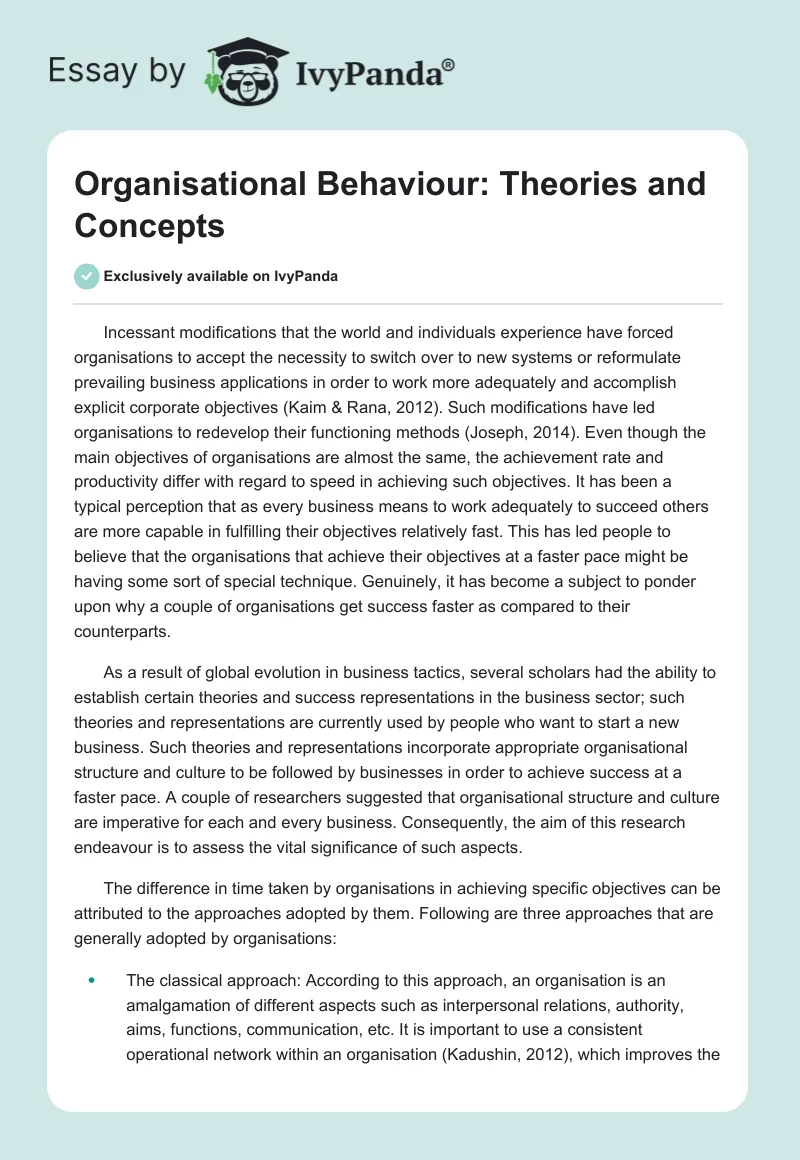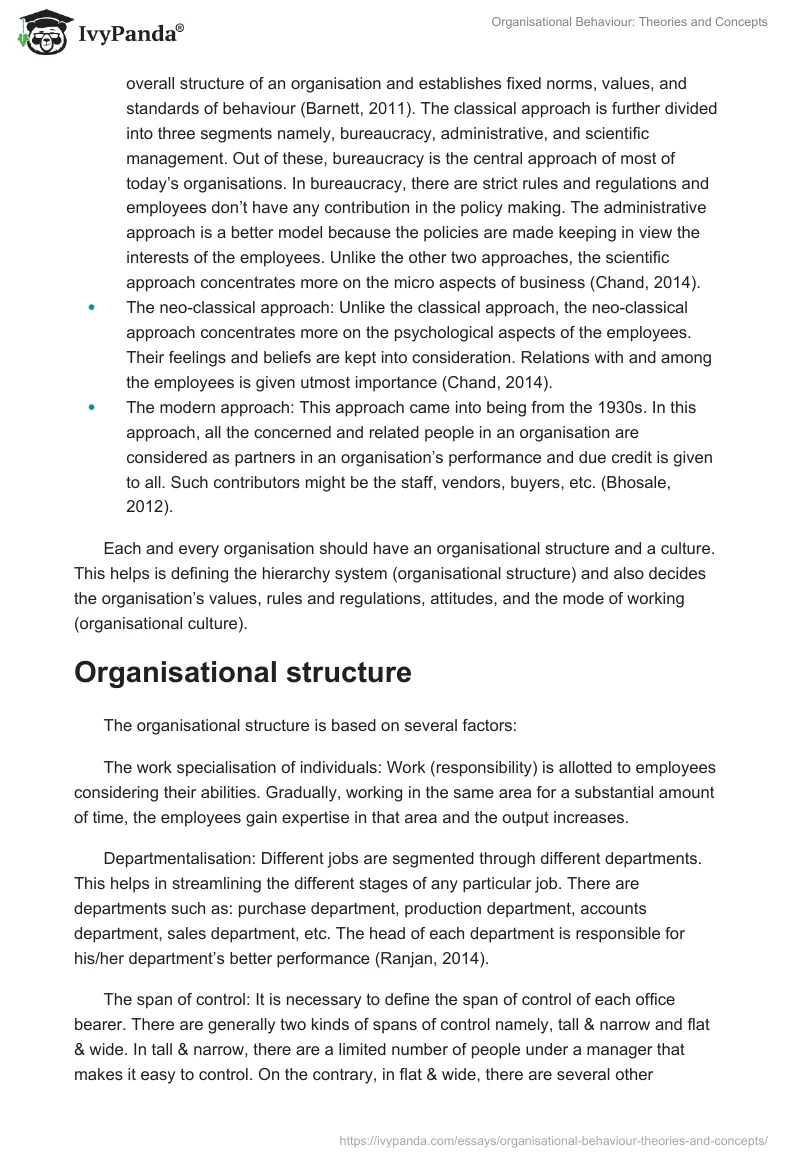Incessant modifications that the world and individuals experience have forced organisations to accept the necessity to switch over to new systems or reformulate prevailing business applications in order to work more adequately and accomplish explicit corporate objectives (Kaim & Rana, 2012). Such modifications have led organisations to redevelop their functioning methods (Joseph, 2014). Even though the main objectives of organisations are almost the same, the achievement rate and productivity differ with regard to speed in achieving such objectives. It has been a typical perception that as every business means to work adequately to succeed others are more capable in fulfilling their objectives relatively fast. This has led people to believe that the organisations that achieve their objectives at a faster pace might be having some sort of special technique. Genuinely, it has become a subject to ponder upon why a couple of organisations get success faster as compared to their counterparts.
As a result of global evolution in business tactics, several scholars had the ability to establish certain theories and success representations in the business sector; such theories and representations are currently used by people who want to start a new business. Such theories and representations incorporate appropriate organisational structure and culture to be followed by businesses in order to achieve success at a faster pace. A couple of researchers suggested that organisational structure and culture are imperative for each and every business. Consequently, the aim of this research endeavour is to assess the vital significance of such aspects.
The difference in time taken by organisations in achieving specific objectives can be attributed to the approaches adopted by them. Following are three approaches that are generally adopted by organisations:
- The classical approach: According to this approach, an organisation is an amalgamation of different aspects such as interpersonal relations, authority, aims, functions, communication, etc. It is important to use a consistent operational network within an organisation (Kadushin, 2012), which improves the overall structure of an organisation and establishes fixed norms, values, and standards of behaviour (Barnett, 2011). The classical approach is further divided into three segments namely, bureaucracy, administrative, and scientific management. Out of these, bureaucracy is the central approach of most of today’s organisations. In bureaucracy, there are strict rules and regulations and employees don’t have any contribution in the policy making. The administrative approach is a better model because the policies are made keeping in view the interests of the employees. Unlike the other two approaches, the scientific approach concentrates more on the micro aspects of business (Chand, 2014).
- The neo-classical approach: Unlike the classical approach, the neo-classical approach concentrates more on the psychological aspects of the employees. Their feelings and beliefs are kept into consideration. Relations with and among the employees is given utmost importance (Chand, 2014).
- The modern approach: This approach came into being from the 1930s. In this approach, all the concerned and related people in an organisation are considered as partners in an organisation’s performance and due credit is given to all. Such contributors might be the staff, vendors, buyers, etc. (Bhosale, 2012).
Each and every organisation should have an organisational structure and a culture. This helps is defining the hierarchy system (organisational structure) and also decides the organisation’s values, rules and regulations, attitudes, and the mode of working (organisational culture).
Organisational structure
The organisational structure is based on several factors:
The work specialisation of individuals: Work (responsibility) is allotted to employees considering their abilities. Gradually, working in the same area for a substantial amount of time, the employees gain expertise in that area and the output increases.
Departmentalisation: Different jobs are segmented through different departments. This helps in streamlining the different stages of any particular job. There are departments such as: purchase department, production department, accounts department, sales department, etc. The head of each department is responsible for his/her department’s better performance (Ranjan, 2014).
The span of control: It is necessary to define the span of control of each office bearer. There are generally two kinds of spans of control namely, tall & narrow and flat & wide. In tall & narrow, there are a limited number of people under a manager that makes it easy to control. On the contrary, in flat & wide, there are several other subordinates – who have yet some more people under them – working under a manager.
Centralisation and decentralisation: As is evident from the names, in centralisation, all the important decisions are taken by the main person and the employees are not even consulted or taken into confidence. On the contrary, in decentralisation, the employees are a part of the decision making process. The latter one is more effective as far as productivity is concerned.
Organisational culture
Organisational culture is of crucial significance to an organisation’s performance. The working atmosphere of an organisation decides its performance (Henle, 2005). If the employees are happy and content, the output will be better and vice-versa. Generally, there are the following types of cultures found in organisations:
- Power culture: this is generally found in small organisations where there is only one person responsible for the business. Other people (staff) are mere workers who work according to the instructions received by them. This kind of a culture is not beneficial for the organisation since the employees are not content with their jobs.
- Welfare culture: this kind of culture is aimed at welfare of the masses and can generally be found in charity organisations and NGOs.
- Task culture: in this kind of a culture, there is a team effort in completing a project. It can be found in organisations that are engaged in projects. The team members are happy and content – because they can take their own decisions within the team – and give better performance.
Role culture: The most commonly found culture in today’s organisations the role culture has definite roles/functions for different employees. The employees have to concentrate on their own job and perform better.
It is a normal practice in organisations to formulate policies and to execute them. Such policies are formed in order to have a better performance and meet the outlined aims and objectives. It is to be understood that such policies are on paper and are not related to the practicalities. As such, in due course of time, an informal system (culture) develops within the organisation that is based purely on the daily workings. It is quite possible that this informal system might be different from the one on paper. The informal system is based on the team work and relationships of the employees (culture). A strong bond is formed and maintained among the employees who start caring for each other and help in each other’s work. This actually is a better way because productivity is bound to increase.
There are various circumstances when organisations have to opt for certain changes in their policies, structure, and even the orientation. The employees are required to adapt to such changes in a manner that might not have adverse effects on the organisation’s performance. It is easy to say all this but when it comes to practically doing such things, the employees find it very difficult to comply. If the organisation has efficient leadership, such issues can be taken care of with ease (CIPD, 2012). As discussed above, there are mainly four kinds of leadership styles namely, autocratic, participative, delegative, and corporate culture (Van-Aswegen & Engelbrecht, 2009). In events of changes in the structure, policies, and/or the orientation, the participative leadership is expected to show better results. In the autocratic leadership, it is not sure whether the employees will listen to their leaders since they were not consulted before the changes were made.
In the delegative leadership style, due to the absence of proper guidance, the employees will not be able to find a proper solution to problems that might have sprung up due to the changes. In corporate culture, because the organisation is big, it is difficult to execute changes immediately. Recent developments in addressing team ineffectiveness involve using technology to meet the growing needs and responsibilities of organisational members (Lee & Wellman, 2012). Technologists believe that introducing GSS in organisations and especially within group meeting settings can contribute significantly to value management and lead to a new powerful network that can shape ethical and moral values among individuals operating in an organisation group (Chen & Kyaw-Phyo, 2012).
There are numerous motivational theories that are adopted by organisations across the globe. It is easy to understand such theories but putting them into practice can be an uphill task, especially in large organisations where there are several locations and departments. In such large organisations, it is also possible that some of the departments, due to their nature of work, might not be able to participate in the motivational courses. Following are some of the motivational theories and their effects:
- Stick or carrot approach: According to this theory, strict discipline (stick) has to be maintained by the employees otherwise suitable punishment is awarded. It has been observed that punishment usually has negative impacts rather than positive ones. On the contrary, the carrot approach, where employees are given due recognition and appraisal has proved to be quite effective (Williams, 2013).
- Managers’ motivation: The managers are responsible for the performance of their respective teams. It is up to them to extract better performance from their team members. For this, they might need to motivate their team members, which can be done by proper and timely appraisals, incentives, loyalty, communication, respect, etc. The team members are satisfied and perform better.
Managers’ motivational theory is quite effective if the proper tools of motivation are used at suitable times. The following are some of such tools: recognition, respect, trust, loyalty, removal of hindrances, quality of job, better communication, and incentives (CIPD, 2012).
Different people have different thoughts and as such, different motivational tools have to be used by managers while dealing with different people. Like some employees would like to work without any time limits. Managers should allow them to work like that, provided they do their job in a perfect manner. Then, there might be some employees who are more concerned with the risks involved in doing any particular job. Such employees might be imparted low-risk jobs, and likewise. It has been observed that generally employees get motivated by the work conditions and the hygiene conditions, in addition to the policies pertaining to salary, increments, leave, growth, job security, etc. so managers need to keep all such factors into consideration while going for motivating the employees.
References
Barnett, G. A. (2011). Encyclopaedia of social networks. Thousand Oaks, CA: Sage.
Bhosale, P. S. (2012). Classical, neo classical and modern theories. Web.
Chand, S. (2014). Major approaches to organisational theory: Classical and neo-classical approaches. Web.
Chen, J., & Kyaw-Phyo, L. (2012). User satisfaction with group decision making process and outcome. Journal of Computer Information Systems, 52(4), 30-39.
CIPD (2012). Leading culture change: Employee engagement and public service transformation. Web.
Henle, C. (2005). Predicting Workplace Deviance from the Interaction between Organizational Justice and Personality. Journal of Managerial Issues, 17(2), 247-63.
Joseph, C. (2014). Forces that may cause change in an organization. Web.
Kadushin, C. (2012). Understanding social networks: Theories, concepts, and findings. Oxford, England: Oxford University Press.
Kaim, A., & Rana, D. (2012). Organizational behaviour. Web.
Lee, R., & Wellman, B. (2012). Networked: The new social operating system. Cambridge, MA: MIT Press.
Ranjan, S. (2014). Fundamentals of organizing. Web.
Van-Aswegen, A., & Engelbrecht, A. (2009). The relationship between transformational leadership, integrity, and an ethical climate in organisations. South African Journal of Human Resource Management, 7(1), 221-229.
Williams, R. B. (2013). Carrot and Stick motivation revisited by new research. Web.


